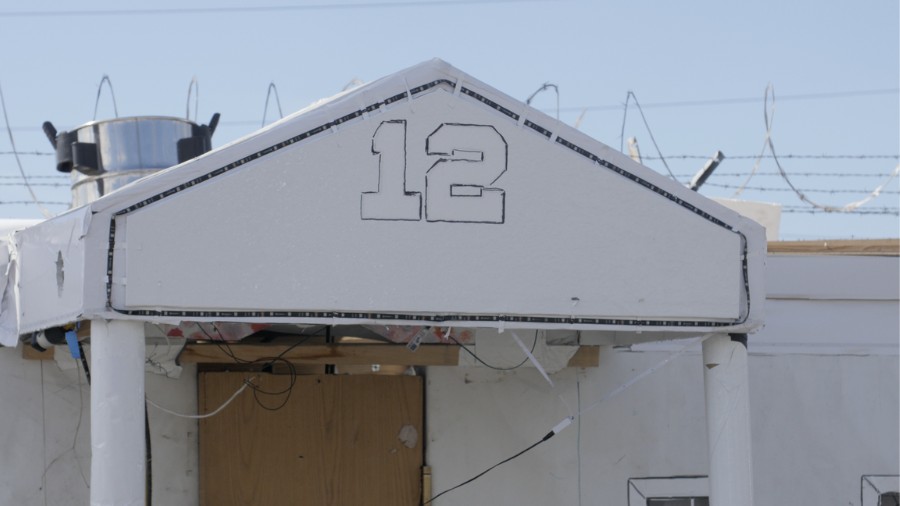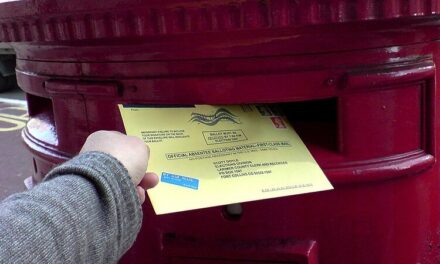We support our Publishers and Content Creators. You can view this story on their website by CLICKING HERE.
The White House now boasts a homeless encampment. Well, the White House is technically a homeless encampment in Seattle. The commander-in-chief here is a man who has previously been identified as Danny. He is a homeless man who has built a replica of the nation’s most famous residence to make a point.
In the city’s SoDo neighborhood, just a few blocks from T-Mobile Park, nestled by the railroad tracks, you’ll find this makeshift White House. The North Portico — well, technically, it’s an East Portico — features two Ionic columns. Above them, “12” is scribbled on the pediment, a tribute to either President Zachary Taylor or, more likely, the NFL’s Seattle Seahawks (smart money’s on the latter).
The tarp structure is “enhanced” with eight cut-out windows (literally, the tarp is cut to resemble windows), perfectly designed to let in the Seattle breeze. The fence surrounding the President’s Palace isn’t quite as secure as what you see in Washington, D.C., but the white picket fence does add additional character. Scattered around the grounds, you’ll find all the essentials for a Seattle homeless encampment: bikes, broken speakers, a traffic cone, and wooden pallets.
For the record, Danny doesn’t consider himself political, isn’t a supporter of Donald Trump but says life was better under him than under Joe Biden.
How did this man become homeless?
This is not the first time Seattle became host to a homeless White House encampment from President Danny. He previously built a White House (with four Ionic columns) but it was taken down by the city. And it’s the homeless policies and use of police, he says, that partly inspired his domicile.
“I kind of feel embarrassed about being down here to a point, but it’s hard to get out of here for the fact of the situation I’m in. My hands are screwed up, I lost my vehicle…” Danny told “The Jason Rantz Show” on KTTH and MyNorthwest.
Danny says he has skills, as evidenced by the craftsmanship of the structure, that he can put to work. He said he previously worked on the 520 bridge walkway, as well as the Space Needle during the 2017 remodel. He was a self-employed painter where he says he made between $1,200 and $1,600 a week. But when he developed carpal tunnel syndrome, it prevented him doing the work.
“The needle gunning, the grinding the paint stuff, it (expletive) my hand up bad. I’d get up in the morning, I couldn’t even open the door,” Danny explained.
Danny explained that after he didn’t show up for work, and the injury worsened, his life started to take a turn.
“It was just hard for me to even go to work. And then, I just fell into a whole bunch of stuff …,” Danny said, pointing to his mother passing away and an allegation that his sister robbed him of his money.
Soon, he ended up living outside.

A tarp structure that resembles the White House can be seen in Seattle’s SoDo neighborhood in September 2024. It has a “12” on the front above two of the columns, presumably a tribute to the NFL’s Seattle Seahawks. (Photo: Patrick Janicek, KIRO Newsradio)
Why did the homeless man set up a Seattle White House?
Back in May, he erected the first Seattle White House iteration, but it came down. Now, he’s doing it again not far from the original spot. It’s not meant to merely highlight his skills but to point out that not all homeless encampments have to be an eyesore.
But having dealt with outreach workers he says works for the city, Danny says he doesn’t have much hope.
“I think that the people that are there to try to help out the homeless and get people off the streets … that’s where all the money’s going because it’s not going to the people that are homeless down here,” Danny complains.
In fact, Danny has a lot of complaints. He says food stamps don’t go far “because of the price of everything.” If either he or his neighbors leave for more than a couple hours, they’re robbed by other homeless people. But his biggest argument seems to revolve around encampment sweeps. He argues they’re counterproductive.
“There’s a lot of people down here that are trying to get out of here, but it’s hard when your stuff gets thrown away,” Danny said.
While the city and county have promoted tiny home communities as a way to help get the homeless back on track, Danny isn’t a fan either. He compares it to a jail because residents “have to sign in and sign out.” But he also said he has been told from the people who live in tiny home villages they have rooms where they “do all your drugs.”
“And everybody I know that’s been any tiny home, except a few people, they’re all back down here. They’ve been kicked out because they didn’t sign in or out one day or something stupid,” he claimed.
Danny epitomizes the homelessness problem
Danny speaks in disjointed thoughts. He starts a sentence, but then switches to a different issue before completing his thought. It’s hard to follow. And that’s just one reason he seems unemployable at the moment. The biggest reason Danny is homeless appears to be Danny himself.
The theme from his conversation is that someone or something else is always to blame for why he’s still living outside. He seems to always have an excuse, but doesn’t appear to realize he’s part of the problem. He’s shown no indication that he actually wants to become a functioning member of society again. While he spends time building his Seattle White House homeless encampment, there are hours in his day that could be better used connecting with social workers and others who can get him the help he needs. Is the help merely medical? I don’t know. But it’s clear he needs help. And being allowed to live outside, making a spectacle of Seattle’s permissive policies around homelessness, won’t ever result in getting a job and a real place to call home.
Predictably, Seattle’s activist community is enabling him.

A tarp structure that resembles the White House can be seen in Seattle’s SoDo neighborhood in September 2024. It has a “12” on the front above two of the columns, presumably a tribute to the NFL’s Seattle Seahawks. Here, the “12” can be seen up close. (Photo: Patrick Janicek, KIRO Newsradio)
Activists enable the homeless
Activist groups, particularly in the SoDo neighborhood, have routinely helped keep people on the streets.
Sweeps in Seattle almost always only happen after significant outreach efforts. But, too often, the homeless reject the help. They won’t live in a tiny house because they don’t want to follow rules. They won’t go into treatment because they don’t have to. A relentless stream of pressure to bring people inside, and making life outside too difficult, is all that works for many homeless people, particularly ones who aren’t burdened by a drug addiction or mental illness. Sweeps can do that. But there’s not merely resistance to sweeps, there are activists who make it easier to avoid the sweep.
“This one particular person that anytime they do a sweep, they come out and a group of people — it’s not outreach, it’s their their own little thing — and they tow all the people’s RVs a couple days before (a sweep) to help them get out. They provide stuff, (like) gas, you name it. And they’re just their own little thing. It’s not paid by the state or anything,” Danny said.
Danny doesn’t seem to realize the anti-sweep activists aren’t actually helping him. They’re making things worse.
This is another story that will end in tragedy
Danny seems like a decent guy, but he’s living in a fantasy, and it’s tough to tell if any story he shares is grounded in reality. The sad truth is, he’s choosing to live outside because he has been given the option to do so.
We have a moral obligation to help people like Danny, especially when they can’t or won’t help themselves. He’s a human being who desperately needs intervention. But Seattle’s approach to homelessness continues to focus too much on waiting for people in dire straits to be the ones to ask for help. Pride, addiction and mental illness often get in the way of homeless people seeking or accepting assistance. The city’s reluctance to conduct sweeps, allowing encampments to grow unchecked and offering no real consequences for illegal behavior, sends the wrong message. Why would Danny feel any pressure to accept help when he can keep doing whatever he wants without facing repercussions?
If we genuinely want to get people off the streets, we have to make it so staying on the streets isn’t an option. Otherwise, Danny’s “White House” won’t be the last homeless encampment to tarnish the city’s image.
Listen to The Jason Rantz Show on weekday afternoons from 3-7 p.m. on KTTH 770 AM (HD Radio 97.3 FM HD-Channel 3). Subscribe to the podcast here. Follow Jason on X, Instagram and Facebook.

 Conservative
Conservative  Search
Search Trending
Trending Current News
Current News 





